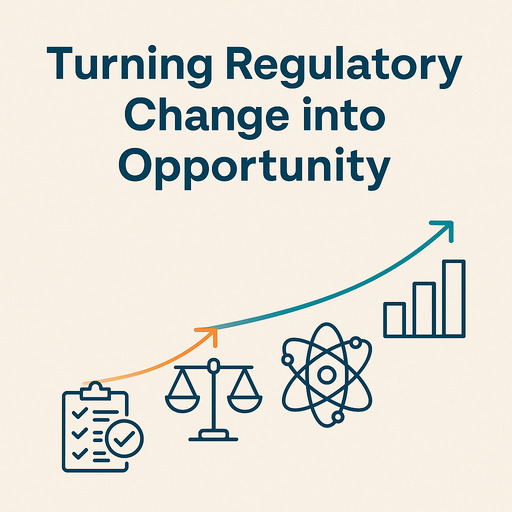 Regulatory change is one of the constants in many industries*. Every few years, a new set of requirements emerges—often with the stated goal of protecting consumers, increasing transparency, or ensuring the stability of the market.
Regulatory change is one of the constants in many industries*. Every few years, a new set of requirements emerges—often with the stated goal of protecting consumers, increasing transparency, or ensuring the stability of the market.
* Industries particularly susceptible to regulatory change include:
- financial services (insurance, investments and banking)
- healthcare and life sciences
- pharmaceuticals and biotechnology
- energy and utilities
- telecommunications and technology
- transport and aviation
- food and agriculture
Yet, for many firms, the immediate reaction is predictable: more cost, more complexity, more burden.
Problem: Why Regulation Feels Like a Burden
Executives often see regulation through the lens of compliance costs.
-
New processes to design and implement.
-
Additional checks and balances to satisfy auditors.
-
Training programmes for staff at every level.
-
Ongoing monitoring and reporting requirements.
It’s easy to understand why regulation feels like a box-ticking exercise that drains resources without adding much to the bottom line.
But this narrow view comes with a risk.
Implication: The Cost of Missing the Bigger Picture
Regulations are not just about constraints. They also reshape consumer expectations and industry norms.
Firms that treat regulation as only a burden may:
-
Miss chances to build customer trust by being first to embrace higher standards.
-
Fail to identify new market opportunities created by shifts in behaviour.
-
Lose ground to competitors who use compliance as a platform for innovation.
History is full of examples where firms that embraced change thrived, while those that resisted fell behind.
But let's face it, it can be difficult to see the opportunity when change is enforced from the outside.
Opportunity: How AI Can Change the Conversation
This is where AI can make a difference.
AI is particularly good at connecting the dots—linking disparate pieces of information, spotting patterns, and surfacing insights that humans might overlook. It can take what looks like a compliance problem and highlight potential opportunities, such as:
-
Identifying new customer segments created by regulatory protections.
-
Streamlining processes to reduce the true cost of compliance.
-
Suggesting innovative products and services aligned with new rules.
But AI only works if you feed it the right context.
Solution: The Role of StratNav
AI is powerful, but it’s not magic. Without a structured foundation of knowledge, it can generate noise rather than insight.
That’s why tools like StratNav are essential. StratNav captures and organises your:
-
Market insights and trend analysis
-
Business model and strategic priorities
-
Operational processes and capabilities
When this information is readily available, AI can dig deeper, helping you:
-
Understand the full impact of new regulations
-
Explore different scenarios and options
-
Surface opportunities that might otherwise remain hidden
Instead of seeing regulation as just another compliance cost, you can position it as a driver of growth, innovation, and competitive advantage.
Closing Thoughts
Regulation is not going away. In fact, as the world gets more complicated and interconnected, it is only likely to increase.
The real question is whether you treat it purely as a burden—or as a chance to improve, innovate, and differentiate.
By combining structured business insight (through StratNav) with the analytical power of AI, firms can turn regulatory change from a cost centre into a catalyst for opportunity.
👉 If you’re facing a regulatory challenge and want to explore how to push beyond compliance and uncover the upside, let’s talk. I’d be happy to share how I—and StratNav—can help.
